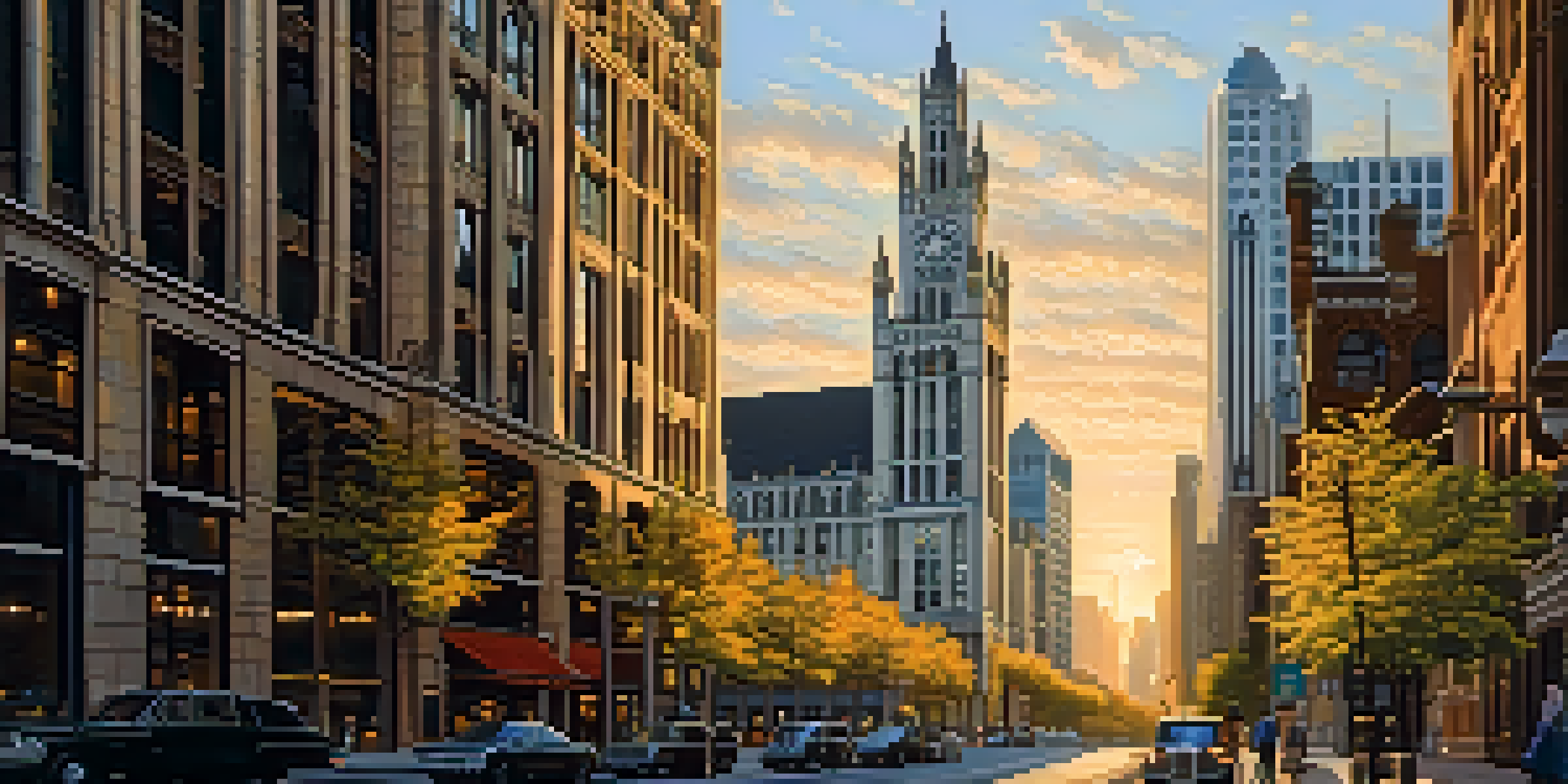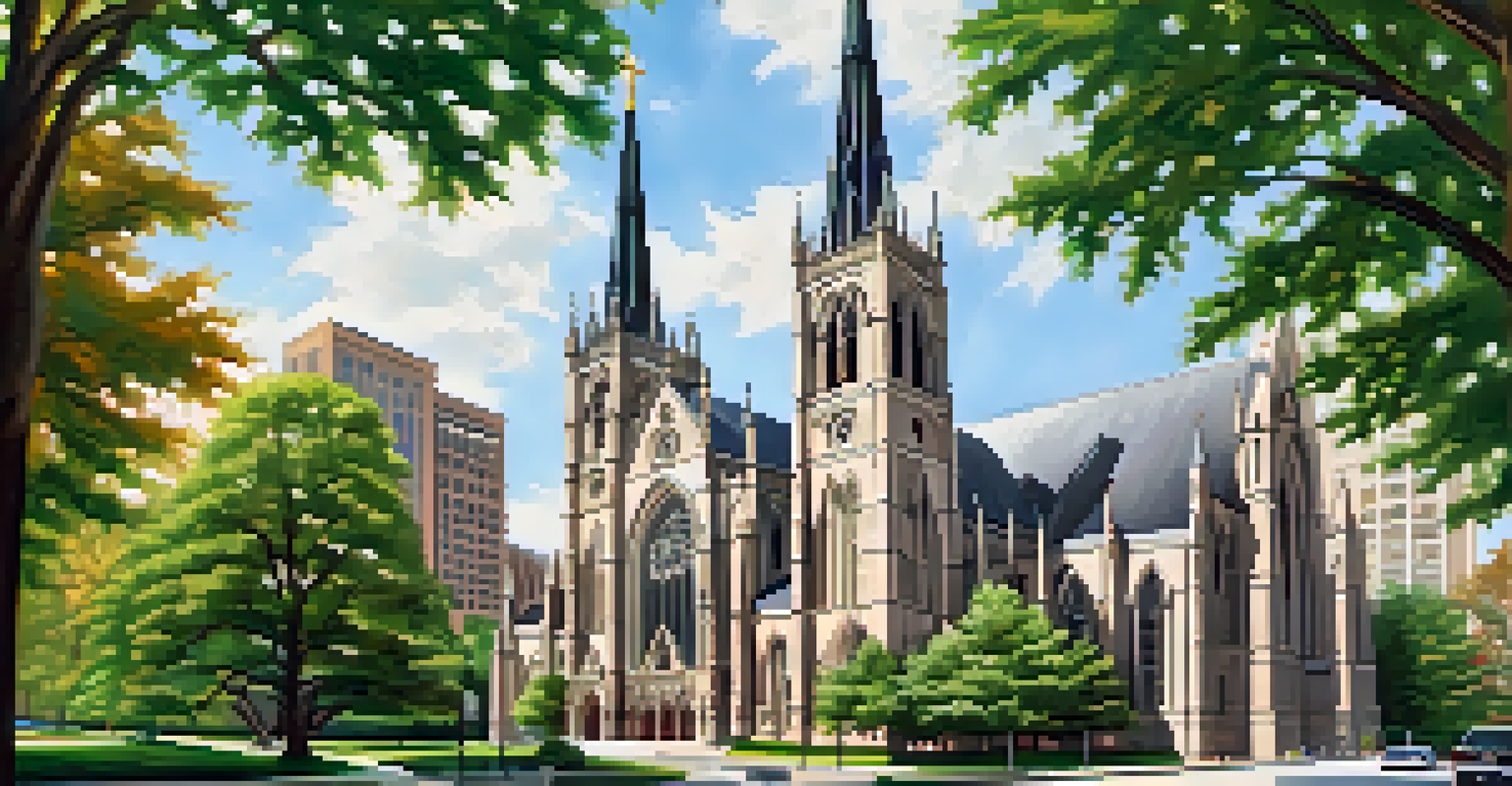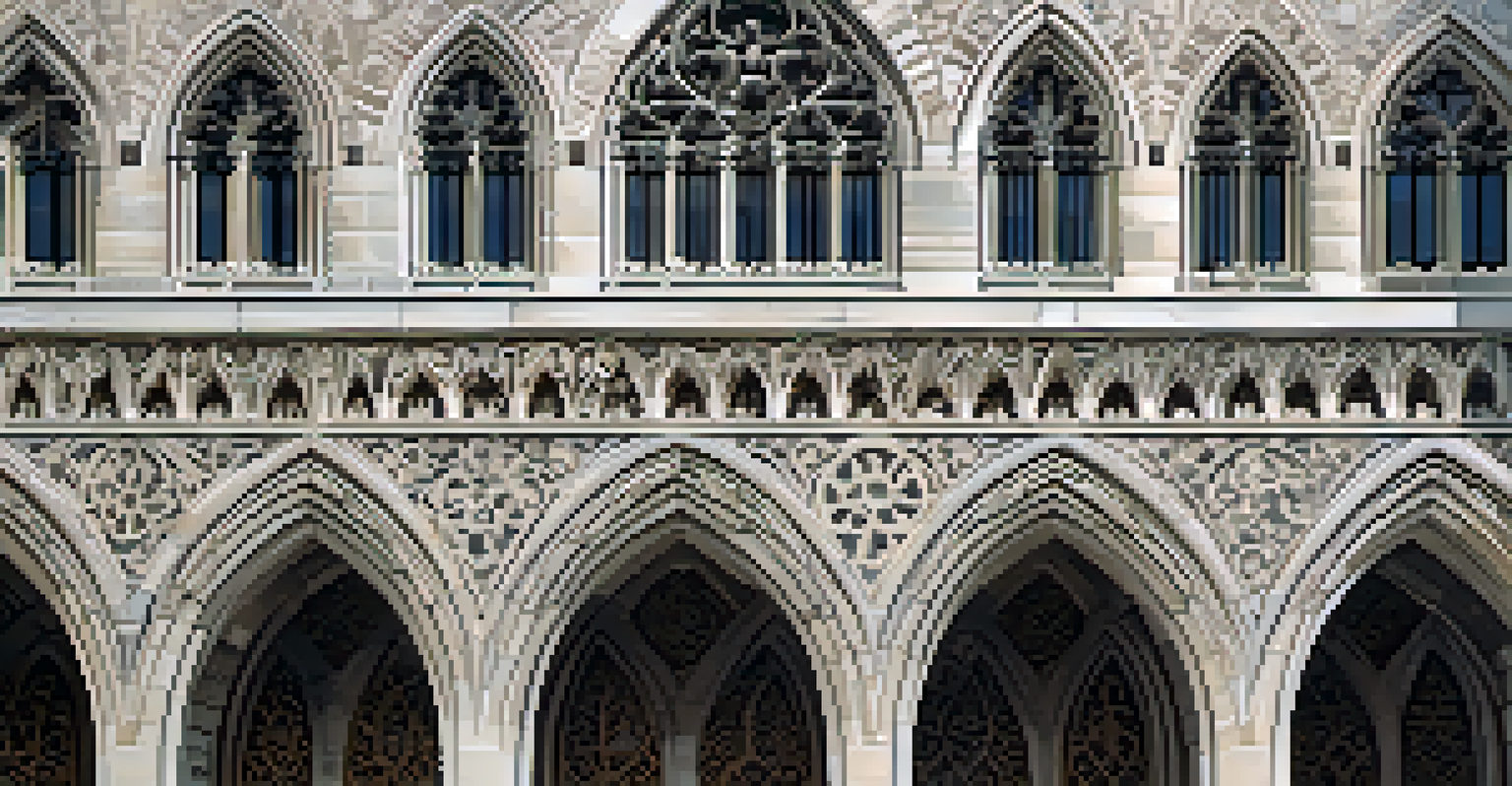Chicago's Gothic Revival: The Allure of Historic Structures

The Gothic Revival Movement: A Brief Overview
The Gothic Revival movement emerged in the late 18th century, inspired by medieval architecture. It sought to revive the grandeur and intricate details of Gothic design, characterized by pointed arches, ornate facades, and soaring spires. This architectural style found a vibrant home in Chicago, where it intertwined with the city's unique history and growth.
Architecture is the art of how to waste space.
As cities expanded and industrialization took hold, the Gothic Revival offered a sense of nostalgia and connection to the past. Architects and builders embraced this style as a way to convey stability and tradition amid rapid change. In Chicago, this movement was particularly significant, reflecting both the city's ambitions and its community values.
Notable examples of Gothic Revival architecture can be found throughout the city, showcasing the versatility and beauty of this style. From cathedrals to universities, these structures tell stories of resilience and artistry, inviting residents and visitors alike to appreciate their historical significance.
Iconic Structures: A Tour of Chicago's Gothic Landmarks
When you think of Gothic Revival in Chicago, the first structure that may come to mind is the magnificent Tribune Tower. Completed in 1925, this skyscraper features an array of Gothic elements, including its intricate stonework and striking flying buttresses. The tower not only serves as a testament to the architectural prowess of its time but also as a symbol of the city’s journalistic legacy.

Another gem in the Gothic Revival crown is St. James Cathedral, a stunning example of ecclesiastical architecture. With its grand spires and detailed stained glass windows, the cathedral stands as a spiritual and artistic beacon in the heart of Chicago. Visiting St. James provides an opportunity to appreciate both its serene atmosphere and its architectural splendor.
Gothic Revival's Chicago Roots
The Gothic Revival movement in Chicago emerged as a response to the city's historical context, particularly after the Great Chicago Fire, symbolizing hope and resilience.
Don't forget to explore the University of Chicago campus, where several buildings showcase the Gothic Revival style. The iconic Harper Memorial Library, with its intricate carvings and majestic arches, serves as a perfect backdrop for students and scholars alike. Each of these landmarks contributes to the rich tapestry of Gothic Revival architecture that defines Chicago.
The Influence of Chicago's History on Gothic Revival
Chicago's unique history played a significant role in shaping its Gothic Revival architecture. Following the Great Chicago Fire of 1871, there was a surge in rebuilding efforts, leading architects to seek styles that conveyed permanence and tradition. The Gothic Revival emerged as the ideal choice, symbolizing hope and renewal for a city looking to rise from the ashes.
The details are not the details. They make the design.
This historical context provided a canvas for architects to blend the old with the new. Many buildings incorporated modern materials while adhering to Gothic design principles, showcasing a harmonious balance of innovation and tradition. As a result, Chicago’s Gothic structures became a visual representation of the city’s resilience and forward-thinking spirit.
The legacy of this architectural movement is still evident today, as Chicagoans take pride in their historical buildings. The Gothic Revival not only reflects the past but also serves as a reminder of the city’s journey through adversity, making each structure a part of Chicago's collective memory.
Materials and Techniques in Gothic Revival Architecture
One of the hallmarks of Gothic Revival architecture is its use of materials that evoke a sense of grandeur. Stone, brick, and intricate carvings are common features, often designed to withstand the test of time. In Chicago, architects utilized local materials to bring their visions to life, creating buildings that are as durable as they are beautiful.
The techniques employed in Gothic Revival construction also played a crucial role in its distinct style. Pointed arches, ribbed vaults, and flying buttresses not only served aesthetic purposes but also provided structural support. This innovative approach allowed for taller and more expansive buildings, a key factor in Chicago's architectural landscape.
Iconic Gothic Landmarks Abound
Chicago is home to significant Gothic Revival structures, such as Tribune Tower and St. James Cathedral, showcasing the beauty and historical importance of this architectural style.
Moreover, the craftsmanship involved in creating these structures is nothing short of remarkable. Skilled artisans poured their heart and soul into every detail, from the delicate stone carvings to the vibrant stained glass windows. This dedication to artistry is what sets Chicago's Gothic Revival apart, making it a lasting legacy that continues to inspire admiration.
Preservation Efforts: Protecting Chicago's Gothic Heritage
As time goes by, the preservation of Chicago's Gothic Revival structures has become increasingly important. Many of these historic buildings face threats from urban development and environmental wear, prompting community efforts to safeguard their architectural heritage. Organizations dedicated to preservation work tirelessly to raise awareness and support for these iconic landmarks.
The city has also implemented policies aimed at protecting its architectural treasures. Designation as a Chicago Landmark or inclusion on the National Register of Historic Places are crucial steps in ensuring that these buildings receive the care and attention they deserve. Such measures help maintain the integrity of Gothic Revival architecture for future generations to enjoy.
Local communities often play a vital role in preservation efforts, rallying around beloved structures and advocating for their maintenance. Whether through fundraising campaigns or educational initiatives, these grassroots movements demonstrate the value that residents place on their city’s historical character. By working together, they help keep Chicago's Gothic Revival legacy alive.
The Modern Influence of Gothic Revival in Chicago
While the height of the Gothic Revival movement may have passed, its influence can still be felt in modern Chicago architecture. Many contemporary buildings draw inspiration from Gothic elements, blending them with modern designs to create a unique aesthetic. This fusion of styles demonstrates the enduring appeal of Gothic Revival principles.
Architects today often incorporate features like pointed arches and intricate detailing into their projects, paying homage to the city's rich architectural past. By embracing these historical elements, they create spaces that resonate with both tradition and innovation. This blend is particularly evident in new constructions that aim to evoke a sense of continuity with the existing urban fabric.
Preserving Architectural Heritage
Efforts to protect Chicago's Gothic Revival buildings are vital for maintaining the city's architectural legacy amid urban development pressures.
Moreover, the popularity of Gothic Revival style in modern architecture serves to reinforce Chicago's identity as a city that values its history. As new generations of architects and designers emerge, they continue to find inspiration in the past, ensuring that the legacy of Gothic Revival remains a vital part of Chicago's architectural narrative.
Exploring Gothic Revival: A Journey for Residents and Tourists
For both residents and tourists, exploring Chicago's Gothic Revival architecture is a rewarding experience. Walking tours offer an immersive way to appreciate the intricate details and historical significance of these structures. Each building tells a story, and guided tours can provide insights that enhance your understanding and appreciation of the architectural landscape.
Visiting these landmarks allows you to step back in time, experiencing the beauty and craftsmanship that define Gothic Revival. Whether you’re admiring the soaring spires of a cathedral or marveling at the intricate stonework of a historic building, there’s something truly captivating about these structures. They invite you to linger, reflect, and connect with the city’s rich heritage.

Additionally, many local organizations host events and programs that celebrate Gothic Revival architecture, encouraging community engagement. From lectures to photography exhibitions, these initiatives foster a deeper connection to Chicago's architectural identity. So, whether you're a lifelong resident or a first-time visitor, taking the time to explore these historic gems is an enriching experience.